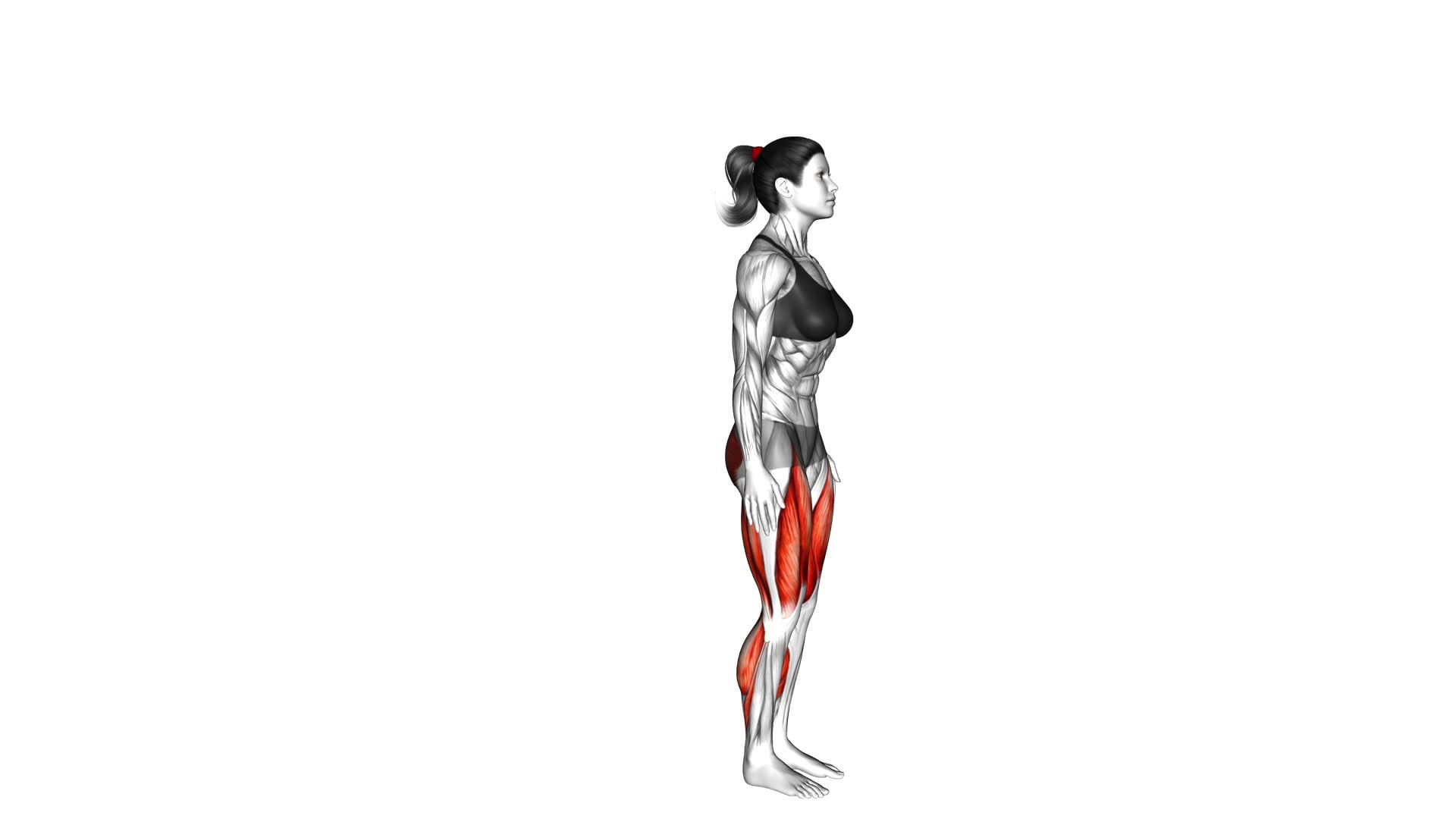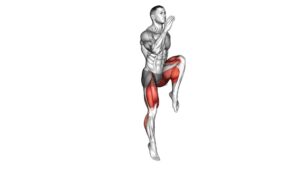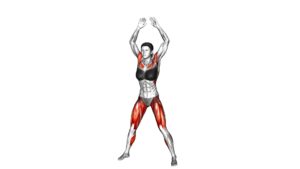Jumping Single Leg Lunge (female) – Video Exercise Guide & Tips

Are you looking to amp up your leg workout routine? Try the Jumping Single Leg Lunge!
Watch This Exercise Video
This exercise targets your quads, glutes, and hamstrings while also improving your balance and agility.
In this video exercise guide, we'll show you the proper form and technique for the Jumping Single Leg Lunge, as well as modifications for beginners or those with injuries.
Watch the video and get ready to take your leg training to the next level!
Key Takeaways
- The Jumping Single Leg Lunge improves explosiveness and strengthens lower body muscles.
- Proper form and technique are crucial, including focusing on knee alignment and engaging the core.
- Maintaining proper knee alignment during the lunge is important to prevent strain on the joint and maximize effectiveness.
- Engaging the core and maintaining hip stability and balance are essential for performing the exercise correctly.
Benefits of the Jumping Single Leg Lunge
Experience three key benefits of the Jumping Single Leg Lunge to enhance your lower body strength and stability.
The Jumping Single Leg Lunge is a powerful exercise that can have a significant impact on your lower body strength and stability. By incorporating this exercise into your workout routine, you can reap several key benefits.
First and foremost, the Jumping Single Leg Lunge is great for improving explosiveness. This exercise requires you to explode off the ground and switch legs mid-air, which helps to develop power in your lower body. By repeatedly performing this movement, you can enhance your ability to generate force quickly, making you more explosive and agile in sports and other physical activities.
Secondly, the Jumping Single Leg Lunge is highly effective in strengthening your lower body. This exercise targets your glutes, quads, and hamstrings, helping to build muscle and improve overall lower body strength. With stronger leg muscles, you can perform everyday activities with ease and reduce the risk of injuries.
Lastly, the Jumping Single Leg Lunge promotes stability in your lower body. By balancing on one leg during the exercise, you engage your core and stabilizing muscles, which in turn improves your balance and coordination. This can be particularly beneficial for athletes who rely on stability and control in their respective sports.
Incorporating the Jumping Single Leg Lunge into your workout routine can be a game-changer for your lower body strength and stability. So why wait? Start reaping these benefits today and take your fitness to the next level.
Proper Form and Technique for the Exercise
To perform the jumping single leg lunge with proper form and technique, it's important to focus on knee alignment, hip stability, and balance.
Keep your knees in line with your toes throughout the movement to avoid placing unnecessary strain on the joints.
Engage your core and maintain a stable hip position to ensure balance and control during the exercise.
Knee Alignment During Lunge
For proper form and technique during the Jumping Single Leg Lunge exercise, focus on maintaining correct knee alignment.
It's essential to ensure that your knee is properly aligned to prevent injury and maximize the effectiveness of the exercise.
One common mistake is allowing the knee to collapse inward or outward during the lunge, which can put unnecessary strain on the joint.
To maintain proper knee alignment, make sure your knee is directly over your ankle when you lower into the lunge.
Avoid letting your knee extend past your toes, as this can also place excessive stress on the knee.
Hip Stability and Balance
Maintain optimal hip stability and balance by engaging your core and keeping your hips level throughout the Jumping Single Leg Lunge exercise. This exercise not only targets your lower body muscles but also challenges your balance and coordination.
Here are some tips to improve your hip stability and balance during the exercise:
- Engage your core: Activate your abdominal muscles by pulling your belly button towards your spine. This will help stabilize your hips and maintain proper alignment.
- Keep your hips level: Avoid any tilting or rotating of your hips by focusing on keeping them parallel to the ground. This will ensure that both sides of your body are working equally.
- Control your landing: When jumping into the lunge position, land softly and with control. This will help prevent any unnecessary stress on your hips and maintain stability.
- Practice balance training: Incorporate exercises that specifically target your balance, such as single-leg exercises or standing on unstable surfaces like a balance board or foam pad. This will help improve your overall hip stability and balance over time.
Modifications for Beginners or Those With Injuries
If you're a beginner or have injuries, modify the jumping single leg lunge to suit your needs. This exercise can be intense and challenging, but there are modifications you can make to ensure safety and prevent further injuries.
For beginners, it's important to start with the basics and focus on stability and balance. Instead of jumping, perform a regular single leg lunge by stepping forward with one leg and lowering your body until your front knee is bent at a 90-degree angle. Keep your back straight and core engaged throughout the movement. This modified version will still target your legs and glutes while reducing the impact on your joints.
If you have injuries, it's crucial to consult with a healthcare professional before attempting any exercise modifications. They can provide personalized advice and guidance based on your specific condition. In some cases, it may be necessary to avoid jumping altogether and focus on low-impact exercises. You can substitute the jumping single leg lunge with exercises such as stationary lunges, bridges, or step-ups. These exercises can help strengthen your muscles without putting excessive strain on your injured areas.
How to Incorporate the Jumping Single Leg Lunge Into Your Workout Routine
To incorporate the jumping single leg lunge into your workout routine, you can experience the benefits of plyometric exercises, which include improved power, agility, and explosive strength.
There are variations available for different levels of fitness, allowing you to adjust the intensity and challenge based on your capabilities.
It's important to maintain proper form and technique throughout the exercise to maximize effectiveness and minimize the risk of injury.
Benefits of Plyometric Exercises
Incorporate the jumping single leg lunge into your workout routine to enhance plyometric exercises and improve lower body strength and explosive power. Plyometric training involves quick, explosive movements that engage multiple muscle groups.
Here are four benefits of incorporating plyometric exercises like the jumping single leg lunge into your workout routine:
- Increased power: Plyometric exercises train your muscles to generate maximum force in a short amount of time, leading to improved explosive power.
- Enhanced agility: Plyometric exercises require rapid changes in direction and quick movements, improving your overall agility and coordination.
- Improved athletic performance: Plyometric exercises mimic the explosive movements commonly used in sports, helping you perform better in activities that require quick bursts of power.
- Stronger lower body: The jumping single leg lunge targets your glutes, quadriceps, hamstrings, and calves, helping to strengthen and tone your lower body.
Incorporating plyometric exercises like the jumping single leg lunge into your workout routine can provide numerous benefits, including increased power, enhanced agility, improved athletic performance, and stronger lower body muscles.
Variations for Different Levels
Start by modifying the jumping single leg lunge to suit your fitness level and gradually progress from there. There are several variations and progressions you can incorporate into your workout routine to challenge yourself and continue improving.
If you're a beginner, you can start with a basic jumping single leg lunge using your body weight. As you become more comfortable and stronger, you can add dumbbells or resistance bands to increase the intensity. Another variation is the elevated jumping single leg lunge, where you place your front foot on a step or bench to increase the range of motion. You can also try adding a hop at the top of the movement to make it more explosive.
These variations will help you continue to challenge your muscles and improve your overall strength and stability. Now, let's move on to the next section and discuss proper form and technique for the jumping single leg lunge.
Proper Form and Technique
To ensure proper form and technique while incorporating the jumping single leg lunge into your workout routine, focus on maintaining balance and engaging your core throughout the movement. Here are some tips to help you perform this exercise correctly:
- Keep your chest up and shoulders back: This will ensure proper alignment and prevent any strain on your lower back.
- Land softly and with control: Avoid slamming your foot down and instead, focus on a controlled landing to minimize impact on your joints.
- Maintain a 90-degree angle with your front knee: This will engage your quadriceps and glutes effectively.
- Avoid common mistakes: Watch out for leaning too far forward, allowing your knee to cave inward, or rushing through the movement.
Modifications for injuries: If you have knee or ankle issues, you can perform a modified version by reducing the depth of your lunge or using a step or elevated surface for support.
Tips for Improving Balance and Agility During the Exercise
Improve your balance and agility during the exercise by focusing on maintaining proper form and engaging your core muscles. This won't only enhance your performance but also help prevent injuries.
To improve explosiveness, make sure to explode off the ground during the jumping motion, using the power from your leg muscles. This will allow you to generate more force and height with each jump, enhancing your overall agility.
Additionally, avoid knee pain by ensuring that your knee stays aligned with your toes during the exercise. This will minimize stress on the knee joint and reduce the risk of discomfort or injury.
Engaging your core muscles throughout the exercise is crucial for maintaining balance. By contracting your abdominal muscles, you stabilize your body and prevent excessive swaying or wobbling.
Remember to breathe continuously and maintain a controlled rhythm, as this will help you stay focused and maintain balance.
Practicing these tips consistently won't only improve your balance and agility during the jumping single leg lunge but also carry over to other exercises and activities in your daily life.
Common Mistakes to Avoid When Performing the Jumping Single Leg Lunge
Avoid these three common mistakes when performing the jumping single leg lunge:
- Maintaining proper form: One of the most common mistakes isn't maintaining proper form during the exercise. Ensure that your front knee is aligned with your ankle and doesn't go past your toes. Keep your back straight and engage your core to maintain stability.
- Avoiding excessive jumping: While the exercise involves a jump, it's important to avoid excessive jumping. Focus on controlled movements and avoid jumping too high, as this can strain your joints and increase the risk of injury.
- Not using the correct leg: It's essential to alternate legs during the jumping single leg lunge. Neglecting to switch legs can lead to muscle imbalances and can hinder your progress.
- Modifications for injuries: If you have any injuries or conditions that prevent you from performing the jumping single leg lunge, it's important to modify the exercise. Seek guidance from a professional trainer or physical therapist who can provide alternative exercises or modifications to suit your needs.
Frequently Asked Questions
How Many Calories Does the Jumping Single Leg Lunge Burn?
Jumping Single Leg Lunges can be a great exercise for burning calories and promoting weight loss. By incorporating explosive movements and engaging multiple muscle groups, this exercise can help you burn a significant amount of calories.
However, the exact number of calories burned will vary depending on factors such as your weight, intensity level, and duration of the workout. To maximize calorie burn, focus on maintaining proper form and pushing yourself to work at a challenging intensity.
Can the Jumping Single Leg Lunge Help With Weight Loss?
The jumping single leg lunge is a great exercise to incorporate into your weight loss routine. By adding jumping variations to your lunges, you increase the intensity and calorie burn of the exercise.
This helps you burn more calories and ultimately contribute to weight loss. Additionally, jumping exercises like this lunge can improve your cardiovascular fitness and strengthen your leg muscles.
What Muscles Does the Jumping Single Leg Lunge Target?
The jumping single leg lunge is a great exercise for targeting multiple muscles in your lower body. By incorporating this move into your workout routine, you can strengthen your quads, hamstrings, glutes, and calves.
This exercise also helps improve your balance and stability. To make it more challenging, you can add weights or increase the jump height. If you're a beginner, you can modify the exercise by performing a regular lunge instead.
Is the Jumping Single Leg Lunge Suitable for People With Knee Injuries?
Jumping Single Leg Lunge is a challenging exercise that targets multiple muscles. However, before attempting it, consider whether you have any knee injuries. The jumping motion can put strain on the knees, so it may not be suitable for individuals with knee injuries.
Always prioritize your safety and consult with a medical professional or a trainer for personalized advice.
Remember to check out the Video Exercise Guide & Tips {716112} for further instructions.
Can the Jumping Single Leg Lunge Improve Athletic Performance in Other Sports?
Jumping single leg lunges can indeed improve athletic performance in other sports. By incorporating this exercise into your training routine, you can enhance your agility and balance, which are crucial for excelling in various athletic activities.
This exercise targets multiple muscle groups, including your legs, core, and glutes, helping to build strength and explosiveness. By regularly practicing jumping single leg lunges, you can develop the necessary skills and physical abilities to perform at a higher level in your chosen sport.
Conclusion
Incorporating the jumping single leg lunge into your workout routine offers numerous benefits. This exercise can improve balance, agility, and lower body strength. To maximize the effectiveness of this exercise, it is important to follow proper form and technique. Beginners or those with injuries can make modifications to suit their fitness level. It is crucial to focus on maintaining balance and avoiding common mistakes. With practice and dedication, the jumping single leg lunge can be a valuable addition to your fitness routine.

Author
Years ago, the spark of my life’s passion ignited in my mind the moment I stepped into the local gym for the first time. The inaugural bead of perspiration, the initial endeavor, the very first surge of endorphins, and a sense of pride that washed over me post-workout marked the beginning of my deep-seated interest in strength sports, fitness, and sports nutrition. This very curiosity blossomed rapidly into a profound fascination, propelling me to earn a Master’s degree in Physical Education from the Academy of Physical Education in Krakow, followed by a Sports Manager diploma from the Jagiellonian University. My journey of growth led me to gain more specialized qualifications, such as being a certified personal trainer with a focus on sports dietetics, a lifeguard, and an instructor for wellness and corrective gymnastics. Theoretical knowledge paired seamlessly with practical experience, reinforcing my belief that the transformation of individuals under my guidance was also a reflection of my personal growth. This belief holds true even today. Each day, I strive to push the boundaries and explore new realms. These realms gently elevate me to greater heights. The unique combination of passion for my field and the continuous quest for growth fuels my drive to break new ground.



